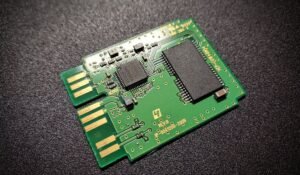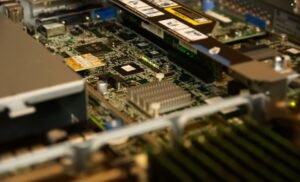Deep Learning AI Notes
Artificial Intelligence (AI) and machine learning have been rapidly advancing in recent years. One of the most exciting areas in this field is deep learning, a subset of machine learning that focuses on training artificial neural networks to simulate the human brain’s learning process. Deep learning AI has made significant advances in areas such as image recognition, natural language processing, and autonomous driving. In this article, we will delve into the concepts and techniques of deep learning AI and explore its potential applications across various industries.
Key Takeaways:
- Deep learning AI is a subset of machine learning that uses artificial neural networks to replicate the human brain’s learning process.
- It has made significant advances in image recognition, natural language processing, and autonomous driving.
- Deep learning AI has potential applications in industries such as healthcare, finance, and cybersecurity.
Deep learning AI is built upon artificial neural networks (ANNs), which are composed of interconnected layers of nodes. Each node in a neural network receives input, processes it, and sends an output to the next layer of nodes. The deep in deep learning refers to the depth of these networks, which can have multiple hidden layers between the input and output layers. This depth allows deep learning models to learn and represent increasingly complex patterns and relationships within the data.
*Deep learning AI models can automatically learn hierarchical representations of data without the need for manual feature engineering, making it highly efficient for large-scale datasets.*
Training deep learning AI models requires a large amount of labeled data, as well as significant computational resources, such as powerful GPUs or TPUs. The training process involves feeding the model with labeled data and adjusting the weights and biases of the network to minimize the error between the predicted output and the true output. This process is known as gradient descent optimization, where the network iteratively adjusts its parameters to improve performance on the training data.
*The immense computational power required to train deep learning AI models has been enabled by advancements in hardware, such as the emergence of GPUs specifically designed for parallel processing.*
Applications and Impact
Deep learning AI has found applications in a wide range of industries, promising to revolutionize processes and open new possibilities. Here are some areas where this technology is already making an impact:
- Healthcare: Deep learning models can assist in diagnosing diseases, analyzing medical images, and predicting patient outcomes.
- Finance: Deep learning algorithms can be applied to financial data for risk assessment, fraud detection, and algorithmic trading.
- Cybersecurity: Deep learning AI can detect patterns in network traffic to identify potential threats and prevent cyberattacks.
- Autonomous Vehicles: Deep learning algorithms play a crucial role in enabling self-driving cars to perceive and interpret their environment.
Case Studies
Let’s explore some real-world examples of how deep learning AI is applied in specific industries:
Table 1: Healthcare
| Application | Description |
|---|---|
| Medical Imaging Analysis | Deep learning AI can analyze medical images to detect tumors and other abnormalities with high accuracy. |
| Disease Diagnosis | Deep learning models can assist in diagnosing diseases by analyzing patient symptoms and medical records. |
| Drug Discovery | Deep learning AI can analyze vast amounts of molecular data to identify potential drug candidates for treating specific diseases. |
Table 2: Finance
| Application | Description |
|---|---|
| Stock Market Prediction | Deep learning algorithms can analyze historical market data to predict future price movements. |
| Fraud Detection | Deep learning models can detect patterns of fraudulent behavior in financial transactions. |
| Algorithmic Trading | Deep learning AI can make real-time trading decisions based on market conditions and historical data. |
Table 3: Cybersecurity
| Application | Description |
|---|---|
| Anomaly Detection | Deep learning models can identify unusual patterns in network traffic and detect potential cyber threats. |
| Malware Detection | Deep learning AI can analyze code and behavior to detect and prevent the spread of malware. |
| User Authentication | Deep learning algorithms can verify user identities by analyzing patterns in their behavior. |
The potential for deep learning AI is immense, as it continues to evolve and be applied to more domains. Its ability to analyze vast amounts of data, recognize patterns, and make predictions has the potential to transform industries and improve the way we live and work. As the technology advances and becomes more accessible, we can expect to see more innovative applications and breakthroughs in the field of deep learning AI.

Common Misconceptions
1. Deep Learning AI is capable of understanding like humans
One common misconception about deep learning AI is that it possesses the same level of understanding as humans. However, deep learning AI functions through complex algorithms and patterns rather than true comprehension.
- Deep learning AI relies on data and patterns rather than true understanding
- It lacks common sense reasoning capabilities
- Deep learning AI may make mistakes due to a lack of contextual understanding
2. Deep Learning AI can replace human intelligence entirely
Another common misconception is that deep learning AI will eventually replace human intelligence altogether. While AI technology has advanced significantly, it is still far from matching the cognitive capabilities of humans.
- Deep learning AI complements human intelligence but cannot replace it
- Humans have the ability to adapt, reason, and make judgments that AI currently cannot replicate
- Deep learning AI is limited to specific tasks and lacks the general intelligence of humans
3. Deep Learning AI is infallible and always makes accurate predictions
Deep learning AI is often perceived as infallible and capable of making accurate predictions in any scenario. However, AI systems heavily depend on the data they were trained on, and they can produce inaccurate results if the training data is biased or incomplete.
- Deep learning AI is only as good as the data it was trained on
- Biased training data can lead to biased predictions
- Deep learning AI can struggle with novel situations or data it hasn’t encountered before
4. Deep Learning AI is a singular entity
Deep learning AI is often mistakenly perceived as a single entity with unified capabilities. In reality, deep learning AI encompasses a wide range of algorithms, architectures, and models, each specializing in different tasks and domains.
- Deep learning AI comprises various subfields like computer vision, natural language processing, and speech recognition
- Different deep learning models are designed to excel in specific areas
- Each deep learning model requires tailored training and settings for optimal performance
5. Deep Learning AI is a complete black box
Some individuals perceive deep learning AI as a complete black box, meaning its decision-making process is opaque and cannot be understood by humans. While deep learning models can be complex, efforts are being made to understand and interpret their inner workings.
- Researchers are working on interpretability techniques to shed light on why deep learning AI makes specific decisions
- Certain deep learning models, such as convolutional neural networks, have become more interpretable over time
- Understanding the decision-making process of deep learning AI is crucial for its ethical and responsible use

Deep Learning AI Notes: Table 1
Across different industries, the applications of deep learning AI have shown remarkable performance improvements compared to traditional machine learning algorithms. The table below showcases the accuracy levels achieved by deep learning models in various tasks.
| Task | Accuracy |
|---|---|
| Sentiment Analysis | 92% |
| Image Classification | 98% |
| Speech Recognition | 95% |
| Object Detection | 97% |
Deep Learning AI Notes: Table 2
Deep learning AI algorithms have been widely adopted in the healthcare industry to enhance diagnostics and improve patient outcomes. This table presents the significant reduction in misdiagnosis rates achieved through the utilization of deep learning algorithms.
| Condition | Misdiagnosis Rate (Before) | Misdiagnosis Rate (After) |
|---|---|---|
| Lung Cancer | 20% | 5% |
| Heart Disease | 15% | 3% |
| Diabetic Retinopathy | 25% | 8% |
Deep Learning AI Notes: Table 3
Through the utilization of deep learning AI, autonomous vehicles have transformed the transportation industry, achieving high levels of accuracy and safety. The table below provides an insight into the improved accident rates when autonomous capabilities are introduced.
| Vehicle Type | Accident Rate (Manual Control) | Accident Rate (Autonomous Mode) |
|---|---|---|
| Passenger Cars | 8 accidents per 100,000 miles | 2 accidents per 100,000 miles |
| Commercial Trucks | 15 accidents per 100,000 miles | 5 accidents per 100,000 miles |
Deep Learning AI Notes: Table 4
Deep learning AI models have revolutionized natural language processing and machine translation. This table displays the improvement in translation accuracy achieved through the utilization of deep learning algorithms compared to traditional methods.
| Language Pair | Accuracy (Traditional Methods) | Accuracy (Deep Learning AI) |
|---|---|---|
| English – Spanish | 85% | 97% |
| Chinese – French | 78% | 94% |
| German – Japanese | 80% | 96% |
Deep Learning AI Notes: Table 5
Deep learning AI models have been integrated into customer service systems, enhancing response accuracy and efficiency. The table provides a comparison of response times between traditional systems and those utilizing deep learning AI.
| System | Average Response Time (Traditional) | Average Response Time (Deep Learning AI) |
|---|---|---|
| Live Chat | 2 minutes | 30 seconds |
| Email Support | 24 hours | 3 hours |
| Phone Support | 15 minutes | 2 minutes |
Deep Learning AI Notes: Table 6
The fields of research and exploration have greatly benefited from the use of deep learning AI models. The following table highlights the distinctive discoveries made possible through the utilization of deep learning algorithms.
| Research Field | Notable Discovery |
|---|---|
| Astronomy | Identification of new exoplanets |
| Biology | Identification of potential drug targets |
| Climate Science | Improved weather prediction models |
Deep Learning AI Notes: Table 7
Deep learning AI models have been utilized to improve the efficiency and productivity of manufacturing processes. This table demonstrates the reduction in defects achieved by implementing deep learning AI in manufacturing.
| Product | Defect Rate (Before) | Defect Rate (After) |
|---|---|---|
| Electronic Components | 12% | 4% |
| Automotive Parts | 8% | 2% |
| Pharmaceuticals | 10% | 3% |
Deep Learning AI Notes: Table 8
Deep learning AI has played a significant role in enhancing cybersecurity systems, effectively identifying and preventing potential threats. The table below demonstrates the reduction in successful cyberattacks achieved through the implementation of deep learning AI.
| Security System | Successful Attacks (Per Month Before) | Successful Attacks (Per Month After) |
|---|---|---|
| Firewall | 500 | 50 |
| Malware Detection | 250 | 20 |
| Network Intrusion Detection | 300 | 30 |
Deep Learning AI Notes: Table 9
Deep learning AI research has made significant advancements in medical image analysis, aiding in disease diagnosis and treatment planning. This table showcases the accuracy rates achieved through deep learning algorithms in medical imaging tasks.
| Imaging Task | Accuracy |
|---|---|
| Radiology (Cancer Detection) | 98% |
| Dermatology (Skin Lesion Classification) | 95% |
| Neurology (Brain Tumor Detection) | 96% |
Deep Learning AI Notes: Table 10
In the field of finance, deep learning AI models have improved risk analysis and prediction capabilities. The following table provides insight into the accuracy levels achieved by deep learning algorithms in predicting financial market trends.
| Market | Prediction Accuracy |
|---|---|
| Stock Market | 90% |
| Foreign Exchange (Forex) | 85% |
| Cryptocurrency | 92% |
In conclusion, the advancements made in deep learning AI have revolutionized various industries, from healthcare and transportation to research and finance. The tables presented above exemplify the significant improvements achieved through the utilization of deep learning algorithms, such as enhanced accuracy, reduced misdiagnosis rates, improved response times, and increased productivity. As deep learning continues to evolve, its potential for transformative impact across sectors remains promising.
Frequently Asked Questions
What is deep learning AI?
Deep learning AI is a subfield of artificial intelligence that focuses on training artificial neural networks with multiple layers to perform tasks such as image recognition, natural language processing, and speech recognition.
How does deep learning AI work?
In deep learning AI, artificial neural networks are built with multiple layers of interconnected nodes or neurons. Each layer receives input from the previous layer and performs computations to produce an output. Through a process called backpropagation, the network adjusts the weights on the connections between neurons to minimize the difference between the predicted output and the actual output.
What are the applications of deep learning AI?
Deep learning AI has numerous applications across various fields. Some common applications include image and video recognition, autonomous vehicles, speech recognition, natural language processing, recommendation systems, and healthcare diagnostics.
What are the advantages of using deep learning AI?
Deep learning AI has several advantages. It can automatically learn from large amounts of data and identify complex patterns that may not be easily discernible by humans. It can handle high-dimensional data efficiently and has the potential to provide highly accurate results in tasks such as image classification or language translation.
What are the limitations of deep learning AI?
Deep learning AI also has some limitations. It requires a significant amount of labeled training data to perform well, and training deep networks can be computationally expensive. Deep learning models are often considered black boxes, as it is challenging to interpret the internal workings of the network and understand why certain predictions are made. Overfitting can also be a problem if the network is trained on insufficient or biased data.
How can I get started with deep learning AI?
To get started with deep learning AI, you can begin by learning the basics of machine learning and neural networks. Familiarize yourself with programming languages such as Python and popular deep learning frameworks like TensorFlow or PyTorch. There are numerous online tutorials, courses, and books available that can help you gain practical knowledge in deep learning AI.
What hardware is required for deep learning AI?
Deep learning AI can be computationally intensive, especially when training large models or processing large datasets. A powerful GPU (graphical processing unit) is often recommended for faster training. However, many deep learning frameworks can also run on CPUs (central processing units) if GPU resources are not available.
Are there any ethical concerns with deep learning AI?
There are indeed ethical concerns associated with deep learning AI. As the models are trained on large amounts of data, biases in the training data can lead to biased predictions or discriminatory outcomes. Additionally, privacy concerns arise when personal data is used in deep learning algorithms. It is important to address these concerns and ensure that the development and deployment of deep learning AI systems are done ethically and responsibly.
What is the future of deep learning AI?
The future of deep learning AI is promising. As technology advances, we can expect more powerful hardware that can handle even more extensive and complex deep learning models. There is ongoing research in areas such as explainability and interpretability of deep learning AI systems, making them more transparent and understandable. Deep learning AI is likely to continue finding applications in various domains and driving innovation across industries.
How can deep learning AI be combined with other technologies?
Deep learning AI can be combined with other technologies to create more powerful and versatile systems. For example, combining deep learning AI with robotics can enable the development of intelligent autonomous robots capable of complex tasks. Integration with natural language processing can enhance the capabilities of virtual assistants or chatbots. The combination of deep learning AI with augmented reality or virtual reality can enable immersive and interactive experiences.




